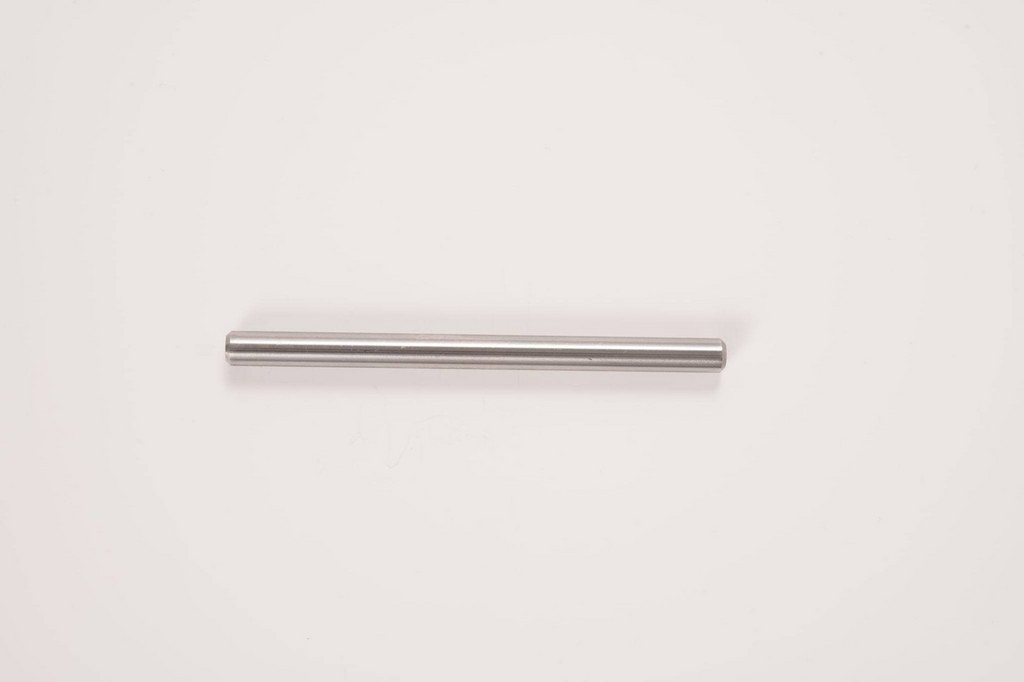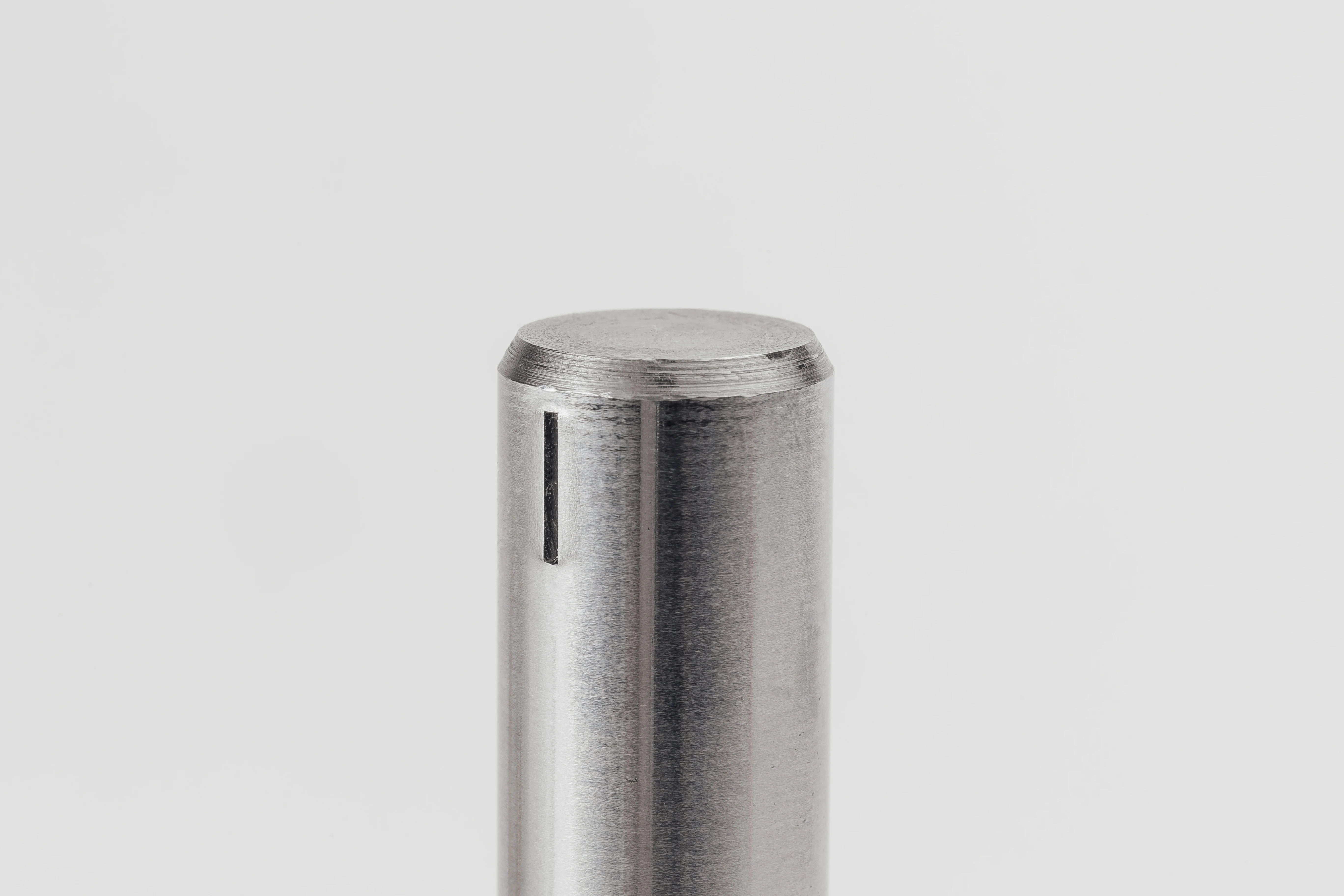2, rue de la Ternière
Avrillé cedex FRANCE
Cylindrical pins are essential fasteners in many mechanical applications. The simple yet effective design of a cylindrical pin makes it ideal for holding mechanical parts together with precision and reliability. Thanks to their smooth metal axis and precision machining, these cylindrical pins integrate perfectly into complex assemblies. Their function is simple but essential, as a mechanical system without a solid fastener is not durable.
The use of computer-aided design (CAD) in the manufacturing process of cylindrical pins enables the shape, size and characteristics of these pins to be optimized to meet the specific needs of each application. Whether for traditional mechanical bar turning or high-precision CNC machining, cylindrical pins are manufactured with consistent quality to ensure flawless assembly.
Cylindrical pin - smooth shaft
What is a cylindrical pin?
A cylindrical pin, as its name implies, has no grooves, splines or other features. grooves or threads on its surface. Cylindrical pins are made from steel, crude steel, stainless steel, brass or aluminum.
A cylindrical pin can be found in various forms:
- Tapered cylindrical pin: its point facilitates insertion into your assembly.
- Cylindrical pin with truncated cone: the point of this shape allows easy insertion while minimizing the risk of slipping.
- The disadvantage of these types of cylindrical pins is that they can cause the part to become dislodged.
- Smooth cylindrical pin the cylindrical plain pin is the most common shape and is found in many applications, reflecting the simplicity and effectiveness of the plain pin. some text
- The smooth cylindrical pin is most often found under the name of ground cylindrical pin.
In which industries are smooth pins used?
The cylindrical pin is an essential assembly element in many fields of engineering and industry. The design and versatility of cylindrical pins make them indispensable in a wide range of applications:
- Automotive industry: cylindrical pins are used to secure drive shafts and camshafts.
- Electrical industry: the cylindrical pin is used to secure electrical components in housings (small diameter).
- Aerospace industry: the cylindrical pin is used to secure various blades.
The manufacture of a cylindrical pin involves precision machining techniques such as mechanical turning or micro-machining, performed on CNC lathes or Escomatic machines. Appropriate heat treatments and surface finishes are also applied to guarantee the quality and durability of a cylindrical pin.
How is the LGC smooth pin made?
The project steps are the same regardless of the product. Let's take the example of a cylindrical pin:
- Gathering customer requirements: Understanding the customer's needs is the first crucial step to a successful project for the mass production of quality cylindrical pins.
- Prototyping phase: LGC can produce prototypes to evaluate different solutions designed by the engineering department, or to test a cylindrical pin against customer requirements.
- Industrialization: The methods office determines the appropriate tools for cutting the material according to the specifications of your cylindrical pin. Initial samples are produced and subjected to rigorous quality controls to ensure compliance with geometric and mechanical standards.
- Series production: Cylindrical pins are produced according to customer orders, with continuous quality control to quickly detect any defects and take corrective action if necessary.
- Final checks: Before shipment, our cylindrical pins undergo a final series of conformity checks carried out by LGC's staff and high-tech machinery, aimed at guaranteeing optimum quality levels, with a target of 0 PPM for the most demanding industrial sectors.
In the case of the cylindrical pin, it's the turning and finishing operation that will differentiate the product range, by determining the shape of the part.
What are the advantages of smooth pins?
The cylindrical pin is a preferred choice in many industrial and engineering contexts, thanks to its distinctive properties and multiple advantages. Here's a detailed analysis of the main benefits associated with the use of cylindrical pins:
- Ease of use: Cylindrical pins are extremely easy to fit, simplifying the component assembly process. This translates into significant time savings when assembling your components.
- Assembly reliability: The cylindrical pin ensures a solid fit between parts, guaranteeing the stability and durability of assembled structures or mechanisms. This robust connection helps prevent unwanted movement between assembled elements.
- High mechanical strength: Designed to withstand heavy loads, the cylindrical pin excels in applications requiring high mechanical strength. This ability to withstand high stresses makes them an essential component in many demanding industrial environments.
- Versatility of application: Cylindrical pins lend themselves to a multitude of applications, from mechanical assembly in the manufacturing industry to sectors as diverse as automotive and aerospace. Their adaptability to different environments and needs makes them a versatile and widely used choice in modern industry.
In short, the cylindrical pin stands out for its ease of use, reliable assembly, high mechanical strength and versatility of application, making it an essential component in many industrial and engineering applications.
Thanks to suitable heat treatments and surface finishes, cylindrical pins can offer increased wear resistance and better adhesion in assemblies.
In the interests of eco-design and sustainability, manufacturing processes for a cylindrical pin often incorporate precision turning and micro-machining techniques, minimizing material waste and resources used. Expert bar turners use CNC lathes and Escomatic machines to produce assembly and positioning pins that meet the highest standards of quality and performance.
In conclusion, cylindrical pins are an essential element in the manufacture of mechanical parts, offering a reliable, precise and adaptable solution for a multitude of industrial and technical applications.
What are the standards for cylindrical pins?
As mentioned above, there are many variations of cylindrical pins. To help you find your way around, here are the different types of cylindrical pins with their DIN and ISO standards:
din 7 cylindrical pin or iso 2338 cylindrical pin: This is a cylindrical pin without slots or chamfers, with dimensional tolerances specified in din 7 or ISO 2338.
Cylindrical pin din 6325 or cylindrical pin iso 8734: This cylindrical pin has a tighter tolerance and is used in applications requiring precise alignment of assembled parts, in compliance with din 6325 or ISO 8734.
Tapped cylindrical pin din 7979 or cylindrical pin iso 8736: This is a tapped cylindrical pin, designed to be used as a connecting and positioning element for assemblies where a perfect fit is required, in accordance with din 7979 or ISO 8736.
Each of these cylindrical pin types has its own characteristics and is adapted to specific applications depending on the requirements of your mechanical assemblies.
Our other pins
Our other spacers
Our other special parts
do the honors,
hover over the images!






